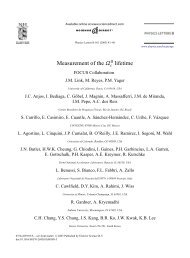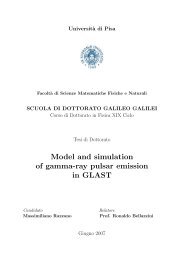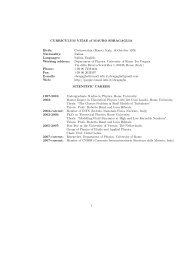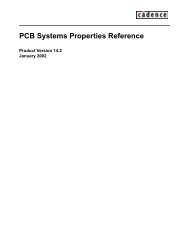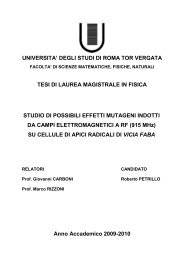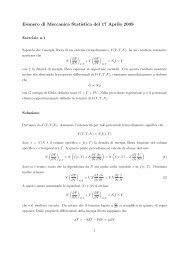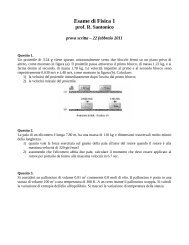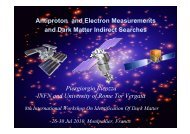A new measurement of the lifetime - Cinvestav
A new measurement of the lifetime - Cinvestav
A new measurement of the lifetime - Cinvestav
Create successful ePaper yourself
Turn your PDF publications into a flip-book with our unique Google optimized e-Paper software.
Physics Letters B 541 (2002) 211–218<br />
www.elsevier.com/locate/npe<br />
A <strong>new</strong> <strong>measurement</strong> <strong>of</strong> <strong>the</strong> 0 c <strong>lifetime</strong><br />
FOCUS Collaboration 1<br />
J.M. Link a ,M.Reyes a ,P.M.Yager a ,J.C.Anjos b ,I.Bediaga b ,C.Göbel b ,J.Magnin b ,<br />
A. Massafferri b ,J.M.deMiranda b ,I.M.Pepe b ,A.C.dosReis b , S. Carrillo c ,<br />
E. Casimiro c ,E.Cuautle c , A. Sánchez-Hernández c ,C.Uribe c ,F.Vázquez c ,<br />
L. Agostino d , L. Cinquini d ,J.P.Cumalat d , B. O’Reilly d ,J.E.Ramirez d , I. Segoni d ,<br />
J.N. Butler e , H.W.K. Cheung e , G. Chiodini e , I. Gaines e , P.H. Garbincius e ,<br />
L.A. Garren e ,E.Gottschalk e ,P.H.Kasper e ,A.E.Kreymer e ,R.Kutschke e ,<br />
L. Benussi f ,S.Bianco f ,F.L.Fabbri f ,A.Zallo f ,C.Cawlfield g ,D.Y.Kim g ,K.S.Park g ,<br />
A. Rahimi g ,J.Wiss g ,R.Gardner h , A. Kryemadhi h ,K.H.Chang i , Y.S. Chung i ,<br />
J.S. Kang i ,B.R.Ko i ,J.W.Kwak i ,K.B.Lee i ,K.Cho j ,H.Park j , G. Alimonti k ,<br />
S. Barberis k ,A.Cerutti k ,M.Boschini k ,P.D’Angelo k ,M.DiCorato k ,P.Dini k ,<br />
L. Edera k ,S.Erba k , M. Giammarchi k ,P.Inzani k ,F.Leveraro k , S. Malvezzi k ,<br />
D. Menasce k , M. Mezzadri k , L. Moroni k ,D.Pedrini k , C. Pontoglio k ,F.Prelz k ,<br />
M. Rovere k ,S.Sala k , T.F. Davenport III l ,V.Arena m ,G.Boca m , G. Bonomi m ,<br />
G. Gianini m , G. Liguori m ,M.M.Merlo m , D. Pantea m ,S.P.Ratti m , C. Riccardi m ,<br />
P. Vitulo m , H. Hernandez n ,A.M.Lopez n ,H.Mendez n ,L.Mendez n ,E.Montiel n ,<br />
D. Olaya n ,A.Paris n , J. Quinones n ,C.Rivera n ,W.Xiong n ,Y.Zhang n ,J.R.Wilson o ,<br />
T. Handler p , R. Mitchell p ,D.Engh q ,M.Hosack q , W.E. Johns q ,M.Nehring q ,<br />
P.D. Sheldon q ,K.Stenson q , E.W. Vaandering q ,M.Webster q ,M.Sheaff r<br />
a University <strong>of</strong> California, Davis, CA 95616, USA<br />
b Centro Brasileiro de Pesquisas Físicas, Rio de Janeiro, RJ, Brazil<br />
c CINVESTAV, 07000 México City, DF, Mexico<br />
d University <strong>of</strong> Colorado, Boulder, CO 80309, USA<br />
e Fermi National Accelerator Laboratory, Batavia, IL 60510, USA<br />
f Laboratori Nazionali di Frascati dell’INFN, Frascati, I-00044, Italy<br />
g University <strong>of</strong> Illinois, Urbana-Champaign, IL 61801, USA<br />
h Indiana University, Bloomington, IN 47405, USA<br />
i Korea University, Seoul, 136-701, South Korea<br />
j Kyungpook National University, Taegu, 702-701, South Korea<br />
k INFN and University <strong>of</strong> Milano, Milano, Italy<br />
l University <strong>of</strong> North Carolina, Asheville, NC 28804, USA<br />
m Dipartimento di Fisica Nucleare e Teorica and INFN, Pavia, Italy<br />
n University <strong>of</strong> Puerto Rico, Mayaguez, PR 00681, USA<br />
o University <strong>of</strong> South Carolina, Columbia, SC 29208, USA<br />
0370-2693/02/$ – see front matter © 2002 Elsevier Science B.V. All rights reserved.<br />
PII: S0370-2693(02)02239-6
212 FOCUS Collaboration / Physics Letters B 541 (2002) 211–218<br />
p University <strong>of</strong> Tennessee, Knoxville, TN 37996, USA<br />
q Vanderbilt University, Nashville, TN 37235, USA<br />
r University <strong>of</strong> Wisconsin, Madison, WI 53706, USA<br />
Received 29 June 2002; accepted 2 July 2002<br />
Editor: L. Montanet<br />
Abstract<br />
Using data collected by <strong>the</strong> Fermilab experiment FOCUS, we measure <strong>the</strong> <strong>lifetime</strong> <strong>of</strong> <strong>the</strong> charmed baryon o c using <strong>the</strong> decay<br />
channels o c → − π + and o c → − K + . From a combined sample <strong>of</strong> 110 ± 17 events we find τ( o c ) = 118+14 −12 ± 5fs,where<br />
<strong>the</strong> first and second errors are statistical and systematic, respectively. © 2002 Elsevier Science B.V. All rights reserved.<br />
1. Introduction<br />
While <strong>the</strong> <strong>lifetime</strong> hierarchy <strong>of</strong> <strong>the</strong> weakly decaying<br />
charm mesons is well established experimentally<br />
[1] and in fairly good agreement with <strong>the</strong>oretical calculations<br />
[2], <strong>the</strong> pattern <strong>of</strong> <strong>lifetime</strong>s in <strong>the</strong> charm<br />
baryon sector still needs to be established both experimentally<br />
and <strong>the</strong>oretically [3]. While <strong>the</strong> + c <strong>lifetime</strong><br />
is known to an accuracy <strong>of</strong> about 2% [4–6], and recently<br />
<strong>the</strong> + c <strong>lifetime</strong> has been determined to an accuracy<br />
<strong>of</strong> 5% [7], <strong>the</strong> 0 c and 0 c <strong>lifetime</strong>s remain known<br />
to only 20% and 30%, respectively.<br />
The <strong>lifetime</strong> <strong>of</strong> <strong>the</strong> 0 c has been measured by<br />
two experiments. CERN experiment NA32 found<br />
a <strong>lifetime</strong> <strong>of</strong> 82 +59<br />
−30<br />
fs using four events reconstructed<br />
in <strong>the</strong> decay channel 0 c → pK− ̅K ∗0 [8]. Fermilab<br />
experiment E687 [9] measured a 0 c <strong>lifetime</strong> [10] <strong>of</strong><br />
101 +25<br />
−17<br />
(stat) ±5 (sys) fs using 42 events from <strong>the</strong><br />
decay 0 c → − π + .<br />
FOCUS (Fermilab E831) is a general purpose experiment<br />
investigating charm physics. The charmed<br />
particles are produced by <strong>the</strong> interaction <strong>of</strong> a photon<br />
beam on a segmented BeO target. The average energy<br />
<strong>of</strong> <strong>the</strong> beam for <strong>the</strong> data collected for this <strong>measurement</strong><br />
is about 180 GeV. The track reconstruction is accomplished<br />
by two silicon vertex detectors [11,12] (TS and<br />
SSD) in <strong>the</strong> target region and by five multi-wire proportional<br />
chambers (MWPC) downstream <strong>of</strong> <strong>the</strong> target<br />
region. The charged momenta are determined by<br />
E-mail address: segoni@pizero.colorado.edu (I. Segoni).<br />
1 See http://www-focus.fnal.gov/authors.html for additional author<br />
information.<br />
a <strong>measurement</strong> <strong>of</strong> <strong>the</strong> bending angles in two magnets<br />
<strong>of</strong> opposite polarity. Due to <strong>the</strong> excellent separation<br />
between production and decay vertices provided by<br />
<strong>the</strong> silicon detectors, we achieve an average proper<br />
time resolution <strong>of</strong> about 50 fs for <strong>the</strong> decay channels<br />
used in this analysis. Charged particle identification <strong>of</strong><br />
hadrons is performed with three multi-cell threshold<br />
Čerenkov counters [13].<br />
2. Reconstruction <strong>of</strong> hyperons − and −<br />
We reconstruct <strong>the</strong> decay modes 0 c → − π +<br />
and o c → − K + . A detailed description <strong>of</strong> <strong>the</strong><br />
reconstruction method and <strong>the</strong> mass spectra <strong>of</strong> <strong>the</strong><br />
hyperons − and − is in Ref. [14]. We reconstruct<br />
<strong>the</strong> − decay channel 0 π − and <strong>the</strong> − decay<br />
channel 0 K − . While <strong>the</strong>se decay topologies are very<br />
similar, we can easily distinguish between <strong>the</strong>m using<br />
Čerenkov identification <strong>of</strong> <strong>the</strong> final state particles and<br />
by requirements <strong>of</strong> <strong>the</strong> reconstructed invariant masses.<br />
We reconstruct <strong>the</strong> entire decay chain <strong>of</strong> <strong>the</strong>se two<br />
modes. The 0 is identified by its decay into a proton<br />
and an oppositely charged pion. The tracks <strong>of</strong> <strong>the</strong>se<br />
charged daughters are used to form <strong>the</strong> decay vertex<br />
<strong>of</strong> <strong>the</strong> 0 and to determine its flight direction and<br />
momentum. This direction is used toge<strong>the</strong>r with <strong>the</strong><br />
momentum <strong>of</strong> ei<strong>the</strong>r <strong>the</strong> π − or <strong>the</strong> K − , to determine<br />
<strong>the</strong> decay vertex and momentum <strong>of</strong> <strong>the</strong> hyperon. The<br />
hyperon vertex must lie upstream <strong>of</strong> <strong>the</strong> 0 vertex.<br />
Finally, <strong>the</strong> position and momentum vector <strong>of</strong> <strong>the</strong><br />
hyperon is matched to a SSD track.
FOCUS Collaboration / Physics Letters B 541 (2002) 211–218 213<br />
For both modes we compute <strong>the</strong> invariant mass <strong>of</strong><br />
<strong>the</strong> two body combination and select <strong>the</strong> events which<br />
are in <strong>the</strong> correct hyperon mass region. For <strong>the</strong> − we<br />
require 1.312 GeV/c 2 −10 and a momentum<br />
greater than 7 GeV/c.<br />
For <strong>the</strong> − K + mode, <strong>the</strong> detachment cut is l/σ l ><br />
0.5. For <strong>the</strong> secondary vertex we require CLS > 1%.<br />
To identify kaons, we require W p − W K > −0.1 and<br />
W π − W K > 1, comparing <strong>the</strong> kaon hypo<strong>the</strong>sis to <strong>the</strong><br />
proton and <strong>the</strong> pion hypo<strong>the</strong>sis. Since − particles<br />
are produced more copiously than − particles, we<br />
compute <strong>the</strong> invariant mass for <strong>the</strong> − when it<br />
is calculated as a 0 π − combination. To eliminate<br />
− contamination under <strong>the</strong> − mass, we require<br />
M( 0 π − )>1.375 GeV/c 2 .<br />
Fig. 1 shows <strong>the</strong> invariant mass plots for <strong>the</strong> two<br />
modes. The fit is to a Gaussian for <strong>the</strong> signal and<br />
a straight line for <strong>the</strong> background. We do not use <strong>the</strong><br />
fit information to perform <strong>the</strong> <strong>lifetime</strong> <strong>measurement</strong>.<br />
4. The <strong>lifetime</strong> <strong>measurement</strong><br />
We use a binned maximum likelihood fit method<br />
to measure <strong>the</strong> <strong>lifetime</strong>. The fitted histogram is <strong>the</strong> reduced<br />
proper time distribution: t ′ = (l−Nσ l )/(βγ c),<br />
where N is <strong>the</strong> vertex detachment cut, and βγ =<br />
p( 0 c )/M(0 c ). The fit is performed on <strong>the</strong> data in <strong>the</strong><br />
signal region <strong>of</strong> <strong>the</strong> invariant mass distribution: <strong>the</strong><br />
mass window within ±2σ <strong>of</strong> <strong>the</strong> 0 c nominal mass,<br />
where σ is <strong>the</strong> width <strong>of</strong> <strong>the</strong> Gaussian fit <strong>of</strong> <strong>the</strong> invariant<br />
mass distribution. The t ′ distribution <strong>of</strong> <strong>the</strong> signal<br />
region differs from <strong>the</strong> expected behavior e −t ′/τ due to<br />
<strong>the</strong> presence <strong>of</strong> background events. We assume that <strong>the</strong><br />
background events in <strong>the</strong> signal region have <strong>the</strong> same<br />
time distribution as <strong>the</strong> events <strong>of</strong> <strong>the</strong> sidebands (located<br />
between 5 and 9 σ away from <strong>the</strong> 0 c mass). If<br />
S is <strong>the</strong> total number <strong>of</strong> signal events in <strong>the</strong> signal region,<br />
and B is <strong>the</strong> total number <strong>of</strong> background events<br />
in <strong>the</strong> signal region, <strong>the</strong> expected number <strong>of</strong> events n i<br />
in <strong>the</strong> ith bin <strong>of</strong> <strong>the</strong> t ′ distribution is:<br />
n i = S f(t′ i )e−t i ′/τ<br />
∑<br />
i f(t′ i )e−t i ′/τ + B b i<br />
∑<br />
i b ,<br />
i<br />
where b i is <strong>the</strong> number <strong>of</strong> events in <strong>the</strong> ith bin <strong>of</strong> <strong>the</strong><br />
sideband t ′ distribution. The Monte Carlo correction<br />
function f(t ′ ) takes into account detector acceptance,
214 FOCUS Collaboration / Physics Letters B 541 (2002) 211–218<br />
Fig. 1. Invariant mass distributions for each mode. The fit uses a Gaussian for <strong>the</strong> signal and a straight line for <strong>the</strong> background. The signal<br />
region is defined by <strong>the</strong> central shaded region. The sideband region, defined by <strong>the</strong> two symmetrical shaded regions, contains <strong>the</strong> events used to<br />
reproduce <strong>the</strong> decay time <strong>of</strong> <strong>the</strong> background events in <strong>the</strong> signal region.<br />
<strong>the</strong> efficiency <strong>of</strong> <strong>the</strong> selection cuts, and absorption <strong>of</strong><br />
<strong>the</strong> daughter particles as a function <strong>of</strong> <strong>the</strong> reduced<br />
proper time. Fig. 2 shows <strong>the</strong> correction functions<br />
for <strong>the</strong> two modes; due to <strong>the</strong> lower detachment cut<br />
we observe a bigger correction for <strong>the</strong> − K + mode.<br />
Fig. 3 shows <strong>the</strong> reduced proper time distribution<br />
for each mode after <strong>the</strong> Monte Carlo correction. For<br />
each mode a likelihood is constructed as <strong>the</strong> product<br />
between <strong>the</strong> Poisson probability <strong>of</strong> observing s i events<br />
in <strong>the</strong> signal region, when n i are expected, and <strong>the</strong><br />
Poisson probability <strong>of</strong> observing ∑ i b i background<br />
events when B are expected. A factor <strong>of</strong> 2 is included<br />
because <strong>the</strong> sidebands are twice as wide as <strong>the</strong> signal<br />
region. The likelihood for each category is thus:<br />
( ∏<br />
L =<br />
i<br />
n s i<br />
i e−n i<br />
s i !<br />
) ( ∑<br />
(2B)<br />
×<br />
( ∑ i b i)!<br />
i b i<br />
e −2B<br />
)<br />
.<br />
To measure τ , we maximize <strong>the</strong> combined likelihood,<br />
which is <strong>the</strong> product <strong>of</strong> <strong>the</strong> likelihoods for <strong>the</strong> two<br />
decay modes:<br />
L 0 c<br />
= L π × L K .<br />
There are three fit parameters: <strong>the</strong> <strong>lifetime</strong> τ ,andfor<br />
each mode <strong>the</strong> background events B. Our fit result is<br />
τ = 118 +14<br />
−12<br />
fs. When fitted separately, we measure for<br />
<strong>the</strong> two decay modes τ( 0 c → − π + ) = 117 +15<br />
−13 fs<br />
and τ( 0 c → − K + ) = 122 +37<br />
−25 fs.<br />
5. Systematic uncertainty determination<br />
The systematic uncertainty was evaluated from<br />
a detailed study <strong>of</strong> different sources: <strong>the</strong> Monte Carlo<br />
production and detector simulation, <strong>the</strong> fitting procedure,<br />
and <strong>the</strong> possible intrinsic bias <strong>of</strong> <strong>the</strong> method.<br />
The Monte Carlo correction function may be incorrect<br />
if <strong>the</strong> Monte Carlo poorly simulates <strong>the</strong> detector<br />
or <strong>the</strong> production characteristics <strong>of</strong> <strong>the</strong> events. For this<br />
reason we extract a systematic uncertainty due to <strong>the</strong><br />
Monte Carlo simulation after a careful study <strong>of</strong> how<br />
well <strong>the</strong> simulation matches <strong>the</strong> data. We analyze effects<br />
from <strong>the</strong> momentum and transverse momentum<br />
<strong>of</strong> 0 c , <strong>the</strong> flavor (particle and antiparticle) <strong>of</strong> <strong>the</strong> 0 c ,<br />
<strong>the</strong> decay mode <strong>of</strong> <strong>the</strong> 0 c , <strong>the</strong> multiplicity and posi-
FOCUS Collaboration / Physics Letters B 541 (2002) 211–218 215<br />
Fig. 2. Monte Carlo correction function f(t ′ ) for each decay mode.<br />
Fig. 3. Reduced proper time distributions, corrected by <strong>the</strong> Monte Carlo correction function, for each decay mode in <strong>the</strong> signal region and <strong>the</strong><br />
sideband region (shaded).
216 FOCUS Collaboration / Physics Letters B 541 (2002) 211–218<br />
Fig. 4. Proper time distribution for <strong>the</strong> two decay modes in <strong>the</strong> signal region and sideband region (shaded).<br />
tion <strong>of</strong> <strong>the</strong> primary vertex, <strong>the</strong> error on <strong>the</strong> decay time<br />
and length, and <strong>the</strong> target region silicon strip detector<br />
(available for 2/3 <strong>of</strong> <strong>the</strong> FOCUS data set). To obtain<br />
a systematic error, we split <strong>the</strong> data into statistically independent<br />
samples, on <strong>the</strong> basis <strong>of</strong> <strong>the</strong> production variables<br />
and <strong>of</strong> <strong>the</strong> mode. Then we compute <strong>the</strong> χ 2 /d.o.f.<br />
for <strong>the</strong> hypo<strong>the</strong>sis <strong>of</strong> consistency <strong>of</strong> <strong>the</strong> <strong>measurement</strong>s.<br />
If we find χ 2 /d.o.f.>1, we rescale <strong>the</strong> errors in order<br />
to have χ 2 /d.o.f. = 1, and extract <strong>the</strong> systematic error<br />
subtracting in quadrature <strong>the</strong> statistical error from<br />
<strong>the</strong> scaled error <strong>of</strong> <strong>the</strong> weighted average <strong>of</strong> <strong>the</strong> independent<br />
<strong>measurement</strong>s. This method is based on <strong>the</strong><br />
S-factor method <strong>of</strong> <strong>the</strong> Particle Data Group [1]. The<br />
only significant effects found are due to primary vertex<br />
multiplicity and 0 c decay mode from which a systematic<br />
uncertainty <strong>of</strong> σ(production) =±3fsisobtained.<br />
The <strong>measurement</strong> we report is from a particular<br />
choice for <strong>the</strong> fit parameters and fitting technique<br />
(namely, <strong>the</strong> binned maximum likelihood technique).<br />
Varying <strong>the</strong>se fitting conditions provides <strong>measurement</strong>s<br />
which are all a priori likely. We calculate a systematic<br />
uncertainty by performing a set <strong>of</strong> <strong>lifetime</strong><br />
<strong>measurement</strong>s with different choices for <strong>the</strong> fitting parameters<br />
and <strong>the</strong> fitting technique. To study systematic<br />
effects related to our choice <strong>of</strong> fitting parameters<br />
we varied <strong>the</strong> location and width <strong>of</strong> <strong>the</strong> sidebands, <strong>the</strong><br />
proper decay time fitting region and bin size. We also<br />
varied <strong>the</strong> correction function f(t ′ ), by using a linear<br />
fit instead <strong>of</strong> <strong>the</strong> bin values.<br />
Since <strong>the</strong> proper time resolution (about 40 fs for<br />
<strong>the</strong> − π + mode and 80 fs for <strong>the</strong> − K + mode)<br />
is close to <strong>the</strong> 0 c <strong>lifetime</strong>, we decided to perform<br />
<strong>the</strong> <strong>measurement</strong> also with a convolved binned likelihood<br />
method [15] to check <strong>the</strong> fitting technique.<br />
In this method, <strong>the</strong> exponential decay is convolved<br />
with <strong>the</strong> smearing due to <strong>the</strong> time resolution. We<br />
used <strong>the</strong> Monte Carlo convolution correction function<br />
), which represents <strong>the</strong> probability <strong>of</strong> reconstructing<br />
an event in <strong>the</strong> decay time bin i when <strong>the</strong><br />
true decay time bin is j. The likelihood is constructed<br />
in <strong>the</strong> same way as explained before, but <strong>the</strong> number<br />
<strong>of</strong> expected events in <strong>the</strong> ith bin becomes:<br />
F(t gen<br />
j<br />
,ti<br />
rec<br />
n i = S<br />
∑j f(tgen j<br />
∑j f(tgen j<br />
,t rec<br />
∑<br />
i<br />
,t rec<br />
i<br />
)e −t j /τ<br />
i<br />
)e −t j /τ + B b i<br />
∑<br />
i b i<br />
.
FOCUS Collaboration / Physics Letters B 541 (2002) 211–218 217<br />
Fig. 5. Mass and <strong>lifetime</strong> distributions for <strong>the</strong> combined sample. (a) Invariant mass distribution; fit with a Gaussian for <strong>the</strong> signal and a first<br />
order polynomial for <strong>the</strong> background. (b) Monte Carlo corrected and sideband subtracted reduced proper time distribution for <strong>the</strong> signal region<br />
(points). The histograms with different shades are <strong>the</strong> time distributions for <strong>the</strong> sidebands for <strong>the</strong> two decay modes (lighter shade: − π + ,<br />
darker shade: − K + ). The dashed line shows <strong>the</strong> result <strong>of</strong> <strong>the</strong> fit.<br />
Table 1<br />
Contributions to <strong>the</strong> systematic uncertainty<br />
Contribution<br />
Systematic (fs)<br />
Production ± 3<br />
Fit ± 4<br />
Method ± 2<br />
Total ± 5<br />
Instead <strong>of</strong> <strong>the</strong> reduced proper decay time, <strong>the</strong> proper<br />
decay time is fit. Fig. 4 shows <strong>the</strong> proper time<br />
distributions. The <strong>lifetime</strong> result <strong>of</strong> <strong>the</strong> convolved<br />
method is <strong>the</strong>n considered as a fur<strong>the</strong>r fit variant. The<br />
systematic uncertainty due to <strong>the</strong> fit variants is given<br />
by <strong>the</strong> variance <strong>of</strong> <strong>the</strong> set <strong>of</strong> <strong>measurement</strong>s. We find<br />
σ(fit) =±4fs.<br />
The Monte Carlo simulation uses an input <strong>lifetime</strong><br />
given by <strong>the</strong> current world average reported from <strong>the</strong><br />
PDG [1] <strong>of</strong> τ( 0 c ) = 98 fs. We investigate <strong>the</strong> range <strong>of</strong><br />
good performance <strong>of</strong> <strong>the</strong> fitting method when <strong>the</strong> input<br />
<strong>lifetime</strong> for <strong>the</strong> correction function is 100 fs with<br />
a mini Monte Carlo study. This consists <strong>of</strong> simulating<br />
a large number <strong>of</strong> samples with <strong>the</strong> same statistics<br />
as our data (both for signal and background events).<br />
We obtain events from exponential decaying populations<br />
with a given <strong>lifetime</strong> for <strong>the</strong> signal and for <strong>the</strong><br />
background. We obtain <strong>the</strong> background <strong>lifetime</strong> by fitting<br />
<strong>the</strong> data sideband distributions to an exponential.<br />
For <strong>the</strong> signal events we study a wide range <strong>of</strong> <strong>lifetime</strong><br />
values (from 10 to 170 fs). Care is taken to account for<br />
<strong>the</strong> time resolution. The method works with an accuracy<br />
better than 10% for <strong>lifetime</strong>s greater than 55 fs.<br />
We study <strong>the</strong> accuracy in <strong>the</strong> range <strong>of</strong> <strong>the</strong> 0 c measured<br />
<strong>lifetime</strong>, and measure a systematic uncertainty<br />
σ(method) <strong>of</strong> ±2 fs. The mini Monte Carlo study also<br />
validates our estimate <strong>of</strong> <strong>the</strong> fit statistical error.<br />
The total systematic uncertainty is obtained by<br />
adding in quadrature <strong>the</strong> contributions from <strong>the</strong> three<br />
independent sources. We thus find σ (sys) =±5fs.<br />
See Table 1 for a summary <strong>of</strong> <strong>the</strong> contributions and<br />
<strong>the</strong> total systematic uncertainty.<br />
6. Conclusions<br />
We have measured <strong>the</strong> <strong>lifetime</strong> <strong>of</strong> <strong>the</strong> charmed<br />
baryon 0 c , fully reconstructing <strong>the</strong> decays 0 c →
218 FOCUS Collaboration / Physics Letters B 541 (2002) 211–218<br />
− π + ,and 0 c → − K + . Fig. 5a shows <strong>the</strong> invariant<br />
mass plot for <strong>the</strong> combined sample. From <strong>the</strong><br />
110 ± 17 reconstructed events we measure τ( 0 c ) =<br />
(stat) ±5 (sys) fs. Fig. 5b shows <strong>the</strong> Monte<br />
Carlo corrected sideband subtracted proper time distribution<br />
for <strong>the</strong> combined sample for <strong>the</strong> signal region<br />
and sideband region. This <strong>measurement</strong> greatly improves<br />
upon <strong>the</strong> accuracy <strong>of</strong> previous <strong>measurement</strong>s,<br />
118 +14<br />
−12<br />
reducing <strong>the</strong> percentage error on <strong>the</strong> 0 c <strong>lifetime</strong> from<br />
20 to 10%.<br />
Acknowledgements<br />
We wish to acknowledge <strong>the</strong> assistance <strong>of</strong> <strong>the</strong><br />
staffs <strong>of</strong> Fermi National Accelerator Laboratory, <strong>the</strong><br />
INFN <strong>of</strong> Italy, and <strong>the</strong> physics departments <strong>of</strong> <strong>the</strong><br />
collaborating institutions. This research was supported<br />
in part by <strong>the</strong> US National Science Foundation, <strong>the</strong> US<br />
Department <strong>of</strong> Energy, <strong>the</strong> Italian Istituto Nazionale<br />
di Fisica Nucleare and Ministero dell’Università e<br />
della Ricerca Scientifica e Tecnologica, <strong>the</strong> Brazilian<br />
Conselho Nacional de Desenvolvimento Científico e<br />
Tecnológico, CONACyT-México, <strong>the</strong> Korean Ministry<br />
<strong>of</strong> Education, and <strong>the</strong> Korean Science and Engineering<br />
Foundation.<br />
References<br />
[1] Particle Data Group, D.E. Groom et al., Eur. Phys. J. C 15<br />
(2000) 1.<br />
[2] G. Bellini, I.I.Y. Bigi, P.J. Dornan, Phys. Rep. 289 (1997) 1.<br />
[3] B. Guberina, B. Melic, Eur. Phys. J. C 2 (1998) 697.<br />
[4] FOCUS Collaboration, J.M. Link et al., Phys. Rev. Lett. 88<br />
(2002) 161801.<br />
[5] CLEO Collaboration, A.H. Mahmood et al., Phys. Rev. Lett. 86<br />
(2001) 2232.<br />
[6] SELEX Collaboration, A. Kushnirenko et al., Phys. Rev.<br />
Lett. 86 (2001) 5243.<br />
[7] FOCUS Collaboration, J.M. Link et al., Phys. Lett. B 523<br />
(2001) 53.<br />
[8] ACCMOR Collaboration, S. Barlag et al., Phys. Lett. B 236<br />
(1990) 495.<br />
[9] E687 Collaboration, P.L. Frabetti et al., Nucl. Instrum. Methods<br />
A 320 (1992) 519.<br />
[10] E687 Collaboration, P.L. Frabetti et al., Phys. Rev. Lett. 70<br />
(1993) 2058.<br />
[11] G. Bellini et al., Nucl. Instrum. Methods A 252 (1986) 366.<br />
[12] FOCUS Collaboration, J.M. Link et al., hep-ex/0204023,<br />
submitted to Nucl. Instrum. Methods.<br />
[13] FOCUS Collaboration, J.M. Link et al., Nucl. Instrum. Methods<br />
A 484 (2002) 270.<br />
[14] FOCUS Collaboration, J.M. Link et al., Nucl. Instrum. Methods<br />
A 484 (2002) 174.<br />
[15] E687 Collaboration, P.L. Frabetti et al., Phys. Lett. B 357<br />
(1995) 678.



